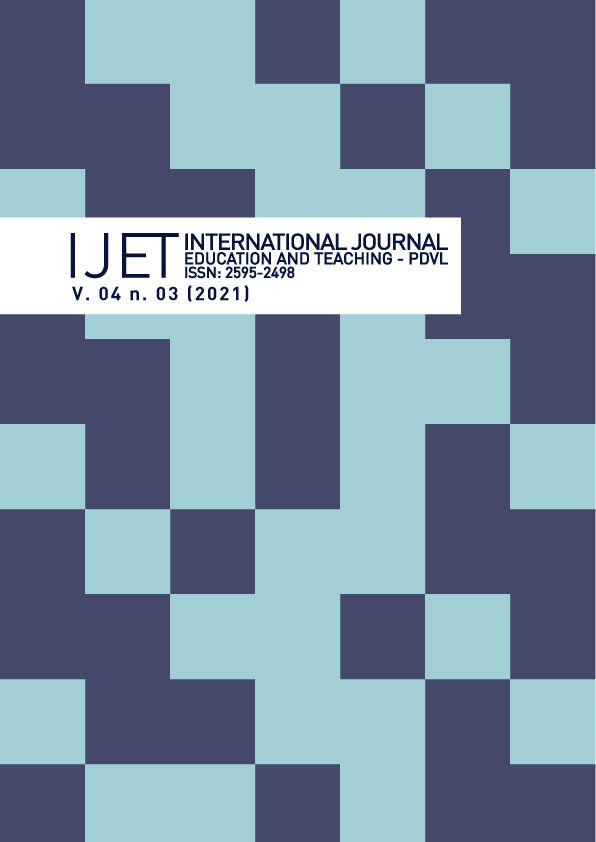APPLICATION OF GUIDING THEMES IN CHEMISTRY TEACHING THROUGH AN INTERDISCIPLINARY APPROACH
DOI:
https://doi.org/10.31692/2595-2498.v5i1.212Keywords:
Chemistry, Colors, Forensics, Lecture SeriesAbstract
One of the premises of public and private universities is to train professionals to work directly in the labor market, which is in constant modernization and progress, which consequently requires more qualified people with more information on various topics. Thus, the Tutorial Education Program - PET Chemistry of the Federal Institute of Paraíba - IFPB, Campus João Pessoa, Brazil, developed an activity called "Cycle of Lectures", designated to students of the Licentiate Degree in Chemistry at this institution, for the purpose to work on interdisciplinary themes that are not present in the curriculum, adding scientific knowledge and awakening a critical look from the participating student. Thus, the present work used a qualitative methodology, containing three moments: i) Application of the Survey Questionnaire (QS); (ii) Two lectures given entitled: "The Chemistry of Colors, why do we see the world in color?" and “Forensic Chemistry: Unraveling Crimes”; (iii) Application of the Final Questionnaire (QF). It is also worth noting that, due to the Covid-19 pandemic experienced by the entire world population, the steps taken were all virtually carried out. In the results, it was possible to verify the relevance of the activity, as well as the development of the students through the lectures given. In the QS, some students knew the themes superficially, but could not relate them to scientific concepts. During the delivery of the lectures, there were several debates and discussions between the participants and the lecturers, with a correlation between the chemical concepts and the themes of the lectures, thus contributing with satisfactory results in the QF. In addition, this activity could corroborate with the PETianos students themselves, since teaching stimulates learning and the exchange of knowledge is essential in the teaching and learning process of students.
Downloads
References
ALMEIDA, E. C. S. et al. Contextualização do ensino de química: motivando alunos de ensino médio. XVI Encontro Nacional de Ensino de Química (XVI ENEQ) e X Encontro de Educação Química da Bahia (X EDUQUI), Salvador, BA, Brasil–17 a, v. 20, 2008.
ATKINS, Peter.; JONES, Loretta.; LAVERMAN, Leroy. Princípios de Química, questionando a vida moderna e o meio ambiente. 3. Ed. Porto Alegre: Bookman, 2018.
BRASIL. Secretaria de Educação Básica. Ministério da Educação. Orientações Curriculares para o Ensino Médio – Linguagens, códigos e suas tecnologias. Brasília, 2006. Disponível em: <http://portal.mec.gov.br/seb/arquivos/pdf/book_volume_01_internet.pdf>. Acesso em 04 out. 2012.
BROWN, Theodore L. et al. Química: a ciência central. 9. ed. São Paulo: Pearson Prentice Hall, 2005.
CAVALCANTI. D. R; BARROS .R. M. Escondendo Manchas de Sangue em Locais de Crime: Análise da Ação Antioxidante dos Chás Verde e Preto Sobre o Luminol. Brazilian Journal of Forensic Sciences, Medical Law and Bioethics, v. 6, n. 1, p. 47- 60,2016. DOI: https://doi.org/10.17063/bjfs6(1)y201647
DE LIMA COUTINHO, Maria da Penha; DO BÚ, Emerson. A técnica de associação livre de palavras sobre o prisma do software tri-deux-mots (version 5.2). Revista Campo do Saber, v. 3, n. 1, 2017.
DESLAURIERS J. P. Recherche Qualitative. Montreal: McGraw Hill, 1991.
FAZENDA, I. Integração e interdisciplinaridade no ensino brasileiro: efetividade ou ideologia. São Paulo, Loyola, 1979.
FREIRE, Paulo. Pedagogia da autonomia: saberes necessários a prática educativa (Coleção
Leitura). São Paulo: Paz e Terra. 1996.
HELFER, Gilson A. et al. Photometrix: An Application for Univariate Calibration and Principal Components Analysis Using Colorimetry on Mobile Devices. Journal of the Brazillian Chemical Society, v. 28, n. 2, p. 328-335, 2017. DOI: https://doi.org/10.5935/0103-5053.20160182
KARGER, Barry L. et al. Graduate Education and Research in Forensic Chemistry at Northeast University.
KRAISIG, Ângela Renata; BRAIBANTE, Mara Elisa Fortes; PAZINATO, Maurícius Selvero. Concepções dos acadêmicos de licenciatura de Ciências da Natureza sobre o tema Cores e processos de Ensino e aprendizagem. Revista Eletrônica de Extensão da URI, Vol. 13, n. 25, p. 67-78, out. 2017. Disponível em: <http://www2.reitoria.uri.br/~vivencias/Numero_025/artigos/pdf/Artigo_07.pdf>. Acesso em: 25/08/2021.
KRAISIG, Ângela Renata; ROCHA, Thaís Rios; BRAIBANTE, Mara Elisa. Abordagem da temática “cores” em um minicurso para estudantes dos cursos técnico e licenciatura em Química. Revista Debates em Ensino de Química, v. 4, n. 2, fev. 2020.
LIMA, A. S. et al. Química Forense. Revista Eletrônica-UNISEP. Disponível em: . Acesso em 25/08/2011.
LUDKE, M.; ANDRÉ, M. E. D. A. Pesquisa em educação: abordagens qualitativas. São Paulo: EPU, 1986.
MOTA, Leandro; DI VITTA, Patrícia Busko. Química forense: utilizando métodos analíticos em favor do poder judiciário. Rev. Acad. Oswaldo Cruz, v. 1, 2014.
ROMÃO, Wanderson et al. Química forense: perspectivas sobre novos métodos analíticos aplicados à documentoscopia, balística e drogas de abuso. Quimica nova, v. 34, n. 10, p. 1717-1728, 2011. DOI: https://doi.org/10.1590/S0100-40422011001000005
SANTOS, Fábio Rocha; AMARAL, Carmem Lúcia Costa. A química forense como tema contextualizador no ensino de química. Research, Society and Development, v. 9, n. 3, p 1-15, 2020. DOI: https://doi.org/10.33448/rsd-v9i3.2772
Downloads
Published
Conference Proceedings Volume
Section
License
Copyright (c) 2022 Evany Mikaelly Cardoso Soares, Joyce dos Santos Farias, Davi Vieira Correia, Ândello Mychael Ferreira Soares da Silva, Alessandra Marcone Tavares Alves de Figueirêdo (Autor)

This work is licensed under a Creative Commons Attribution 4.0 International License.






